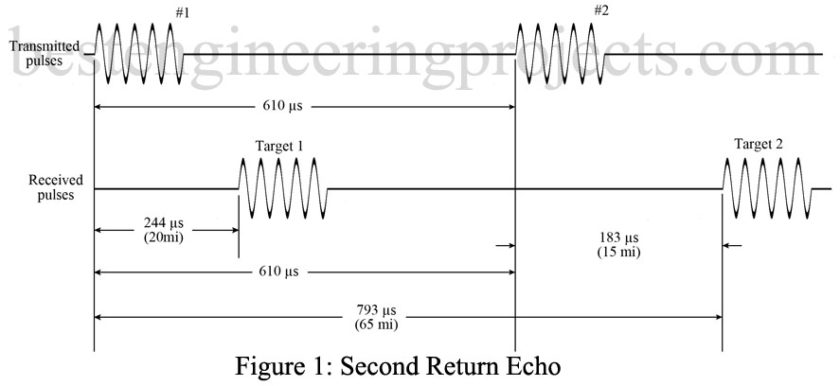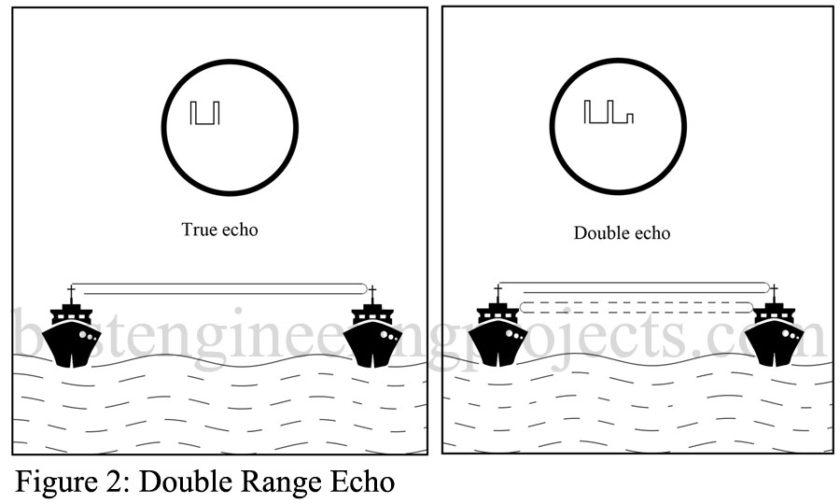Radar System Parameters: Once the pulse of electromagnetic energy is emitted by the radar, a sufficient length of time must elapse to allow any echo signals to return and be detected before the next pulse is transmitted. Therefore, the PRT of the radar is determined by the longest range at which targets are expected. If the PRT were too short (PRF too high), signals from some targets might arrive after the transmission of the next pulse. This could result in ambiguities in measuring range.
Echoes that arrive after the transmission of the next pulse are called second return echoes (also second time around or multiple time around echoes). Such an echo would appear to be at a much shorter target range than actually exists and could be misleading if not identified as a second return echo. The range beyond which targets appear as second return echoes is called the maximum unambiguous range.
Radar System Parameters | Range Calculation
Maximum unambiguous range may be calculated by the formula
maximum unambiguous range = …..(Eq.3)
where range is in miles and the PRT is in microseconds. Figure 1 illustrates the principles of the second return echo.
Figure 1 shows a signal with a PRT of 610 , which results in a maximum unambiguous range of 50 mi. Target number 1 is at a range of 20 mi. Its echo signal takes 244
to return. Target number 2 is actually 65 mi away, and its echo signal takes 793
to return. However, this is 183
after the next pulse was transmitted; therefore, target number 2 will appear to be a weak target 15 mi away. Thus, the maximum unambiguous range is the maximum usable range and will be referred to from now on as simply maximum range. (It is assumed here that the radar has sufficient power and sensitivity to achieve this range.)
If a target is so close to the transmitter that its echo is returned to the receiver before the transmitter is turned off, the reception of the echo will be masked by the transmitted pulse. In addition, almost all radars utilize an electronic device to block the receiver for the duration of the transmitted pulse. However, double range echoes are frequently detected when there is a large target close by. Such echoes are produced when the reflected beam is strong enough to make a second trip, as shown in Fig. 2. Double range echoes are weaker than the main echo and appear at twice the range.
Minimum range is measured in meters and may be calculated by the formula
minimum range = 150 PW …..(Eq.4)
where range is in meters and pulse width (PW) is in microseconds. Typical pulse widths range from fractions of a microsecond for short-range radars to several microseconds for high-power long-range radars.
A radar transmitter generates RF energy in the form of extremely short pulses with comparatively long intervals of rest time. The useful power of the transmitter is that contained in the radiated pulses and is termed the peak power of the system. Because the radar transmitter is resting for a time that is long with respect to the pulse time, the average delivered during one cycle of operation is relatively low compared with the peak power available during the pulse time.
Duty Cycle Calculation
This is another Radar System Parameters. The duty cycle of radar is
…..(5)
For example, the duty cycle of a radar having a pulse width of 2 and a pulse repetition time of 2 ms is
Similarly, the ratio between the average power and peak power may be expressed in terms of the duty cycle. In a system with peak power of 200 kW, a PW of 2 , and a PRT of 2
, a peak power of 200 kW is supplied to the antenna for 2
, while for the remaining 1998
the transmitter output is zero. Because average power equals peak power times duty cycle, the average power equals
, or 200 W.
High peak power is desirable in order to produce a strong echo over the maximum range of the equipment. Conversely, low average power enables the transmitter output circuit components to be made smaller and more compact. Thus, it is advantageous to have a low duty cycle. A short pulse width is also advantageous with respect to being able to “see” closely spaced objects.

